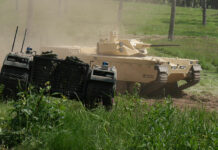Assessment of the Second Lebanon War By Col. David Eshel
 Until the fateful date of July 12, 2006, when the Hezbollah triggered the Second Lebanon War, Israel was accounted an important world power in the development of electronic warfare systems – so much so that a symbiotic relationship evolved for the research and development of many US and Israeli, combat-proven electronic warfare systems. But the first indication of something amiss on the Israeli side already showed up on day three of the Lebanon War. Israeli commanders were certain, having cast an electronic blanket over South Lebanon jamming all Hezbollah communications and telephone networks, including even mobile phones. The IDF general staff were under the illusion that they had also knocked out the communication links between Hassan Nasrallah in Beirut and his local commanders in the combat zone. But they were wrong.
Until the fateful date of July 12, 2006, when the Hezbollah triggered the Second Lebanon War, Israel was accounted an important world power in the development of electronic warfare systems – so much so that a symbiotic relationship evolved for the research and development of many US and Israeli, combat-proven electronic warfare systems. But the first indication of something amiss on the Israeli side already showed up on day three of the Lebanon War. Israeli commanders were certain, having cast an electronic blanket over South Lebanon jamming all Hezbollah communications and telephone networks, including even mobile phones. The IDF general staff were under the illusion that they had also knocked out the communication links between Hassan Nasrallah in Beirut and his local commanders in the combat zone. But they were wrong.
It took them a while to discover that with help of Iranian electronic warfare specialists, Hezbollah had chalked up a major success in, their “Harb Tammus” or the 2006 summer Lebanon War. They had prevented Israeli electronic warfare units from jamming Hezbollah’s communications networks in the battle zone of south Lebanon. In fact, these continued functioning even at the toughest fire-beaten strongholds holding out against Israeli attackst in the combat zone. However, to their surprise, after a fierce battle at Qantara just south of the Litani River, soldiers found the bodies of three Iranian intelligence officers with documents of identification and gear that indicated them as operators of local networks for jamming Israeli radar and communications. Israeli forces searching through the bunkers they cleaned out in South Lebanon were amazed to discover that many contained subterranean state- of the- art communications rooms fitted out with advanced instruments with Iranian encoding equipment.
Brigadier-General Gal Hirsch, the commander of the IDF’s 91 Division, told the press, on 25 July that his troops found rooms full of Iranian-made equipment during the battle for Bint Jbeil (an especially tough Hezbollah stronghold in southern Lebanon), which included eavesdropping devices, computers and modern communications equipment, up-to-date and detailed military maps of Israeli strategic targets, and even lists of telephone numbers inside Israel. Israel’s electronic warfare experts, examining the sites, were surprised by the quality of the equipment they found, the network being, among others, connected by optical fibers which are not susceptible to electronic jamming.
The Iranian electronic engineers’ success proved such that, on Wednesday, Aug. 9, nearly four weeks into the war, Hezbollah’s communications networks were still operating at points only 500 meters from the Israeli border and in spite of repeated bomb strikes on its Al Manar television and Nour Radio studios in south Beirut, both stations remained on the air almost without interruption.
American and Israeli electronic warfare experts, who visited the combat zone, have concluded that Iran had probably decided to use the Lebanon conflict as the testing ground for its military, intelligence and electronic capabilities in preparation for a future clash with the United States and Israel in a potential anti-nuclear conflict. A major element, which declassified Israeli and allied intelligence sources indicate, was concern over the method that Iranian experts managed to render their Beirut embassy totally impregnable to western most advanced electronic or sophisticated hi-tech penetration. Unconfirmed reports even mentioned a war room in an underground bunker under the embassy, having been placed at Hassan Nasrallah and his staff’s disposal, after Hezbollah’s own bunker communications were destroyed by Israeli bombing of Hezbollah’s Beirut Dahiyah district. Although Israeli and American intelligence tried to dismiss Hezbollah officers presence in the embassy, there were several reports that placed Nasrallah and his high command in the Iranian embassy for some time during the war.
But not only with electronic warfare did Hezbollah gain considerable success in penetrating Israeli territorial space. While Iran has assisted Hezbollah by providing advanced intelligence-gathering technology such as reconnaissance drones and sophisticated electronic eavesdropping equipment, Hezbollah HUMINT activities inside Israel managed to recruit valuable information rendering agents. One outstanding example, over such recruitment was the network operated around Omar el-Heib, a Bedouin who served as a lieutenant-colonel in the IDF and was sentenced to 15 years in prison on espionage charges last June. Using Lebanese drug dealers, Hezbollah transferred dozens of kilograms of narcotics to Heib’s network, which was tasked with gathering intelligence on IDF positions and smuggling these across the border, in exchange. Israeli analysts pointed out, that the accurate Hezbollah rocket attacks on IDF military installations, such as the air force monitoring station on Mount Meron, which was attacked at the outset of the war, must have been made possible through local intelligence reports delivered by HUMINT agents.
As for preventative intelligence, against Israeli intelligence penetration onto their own network, Hezbollah had created a special counter intelligence department tasked with enforcing organisational security. This included also an excellent internal signals security apparatus, ensuring that members rarely used communications technology that can be monitored by Israel. It is even rumoured that Hezbollah Secretary-General Hassan Nasrallah himself, has not used a telephone since he became the group’s leader in 1992!
Operational units are also said to have been frequently restructured in recent years, in preparation of the war, enhancing strict compartmentalisation of the various elements in the organisation and thus minimise the risk of infiltration. Finally, Hezbollah’s use of Iranian Unmanned Aerial Vehicles (UAV) has been the most publicised aspect of this intelligence-gathering effort, which may not have been implemented to its fullest effect, through Israeli counter measures during the war, but had substantial public relations result, in raising Israeli concern over these intrusions into its airspace.
For further reading; 2nd Lebanon War Analysis:
















